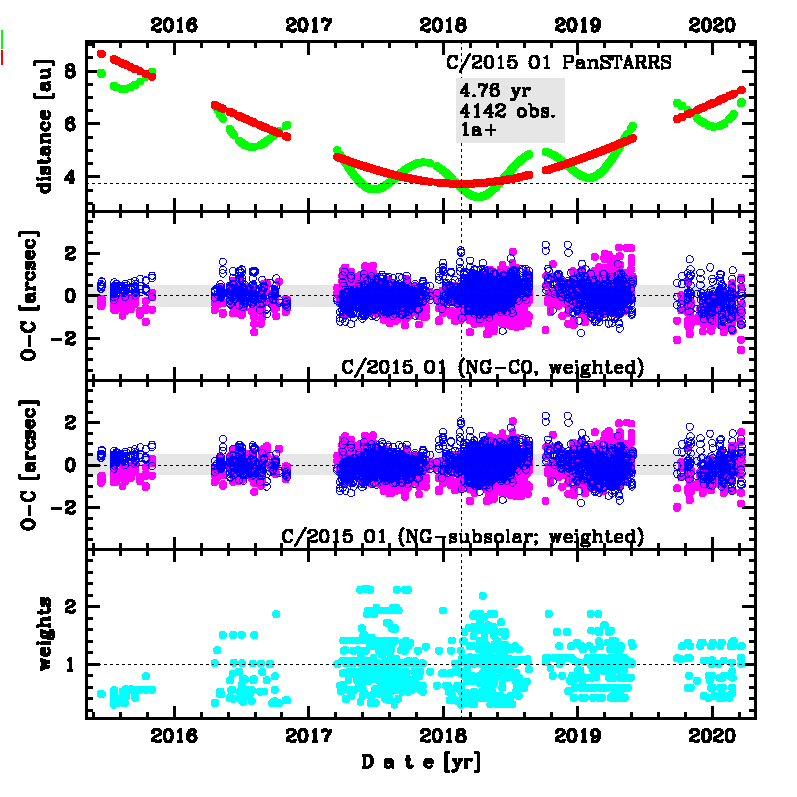C/2015 O1 PANSTARRS
more info
Comet C/2015 O1 was discovered on 19 July 2015 with Pan-STARRS 1 telescope (Haleakala), that is about months after its perihelion passage.
Some prediscovery images of this comet were found: taken on 15 and 17 of June 2015 by Space Surveillance Telescope (Atom Site).
Solutions given here are based on data spanning over 4.76 yr in a range of heliocentric distances: 8.65 au – 3.730 au (perihelion) – 7.28 au.
NG orbits using full data-arc as well as independently using pre-perihelion and post-perihelion data are determinable.
See also Królikowska and Dones 2023.
| solution description | ||
|---|---|---|
| number of observations | 4142 | |
| data interval | 2015 06 15 – 2020 03 20 | |
| data type | perihelion within the observation arc (FULL) | |
| data arc selection | entire data set (STD) | |
| range of heliocentric distances | 8.65 au – 3.73 au (perihelion) – 7.28 au | |
| type of model of motion | NH - non-gravitational orbits for water sublimation from subsolar point | |
| data weighting | YES | |
| number of residuals | 8242 | |
| RMS [arcseconds] | 0.48 | |
| orbit quality class | 1a+ | |
| previous orbit statistics, both Galactic and stellar perturbations were taken into account | ||
|---|---|---|
| no. of returning VCs in the swarm | 5001 | * |
| no. of escaping VCs in the swarm | 0 | |
| no. of hyperbolas among escaping VCs in the swarm | 0 | |
| previous reciprocal semi-major axis [10-6 au-1] | 37.22 – 37.47 – 37.71 | |
| previous perihelion distance [au] | 134 – 141 – 147 | |
| previous aphelion distance [103 au] | 52.9 – 53.24 – 53.59 | |
| time interval to previous perihelion [Myr] | 3.51 – 3.56 – 3.62 | |
| percentage of VCs with qprev > 20 | 100 | |

Upper panel: Time distribution of positional observations with corresponding heliocentric (red curve) and geocentric (green curve) distance at which they were taken. The horizontal dotted line shows the perihelion distance for a given comet whereas vertical dotted line — the moment of perihelion passage.
Middle panel(s): O-C diagram for a given solution (sometimes in comparison to another solution available in CODE), where residuals in right ascension are shown using magenta dots and in declination by blue open circles.
Lowest panel: Relative weights for a given data set(s).
Middle panel(s): O-C diagram for a given solution (sometimes in comparison to another solution available in CODE), where residuals in right ascension are shown using magenta dots and in declination by blue open circles.
Lowest panel: Relative weights for a given data set(s).
| previous_g orbit statistics, here only the Galactic tide has been included | ||
|---|---|---|
| no. of returning VCs in the swarm | 5001 | * |
| no. of escaping VCs in the swarm | 0 | |
| no. of hyperbolas among escaping VCs in the swarm | 0 | |
| previous reciprocal semi-major axis [10-6 au-1] | 40.90 – 41.42 – 41.95 | |
| previous perihelion distance [au] | 10.8 – 11.2 – 11.6 | |
| previous aphelion distance [103 au] | 47.7 – 48.3 – 48.9 | |
| time interval to previous perihelion [Myr] | 3.63 – 3.7 – 3.77 | |
| percentage of VCs with 10 < qprev < 20 | 100 | |